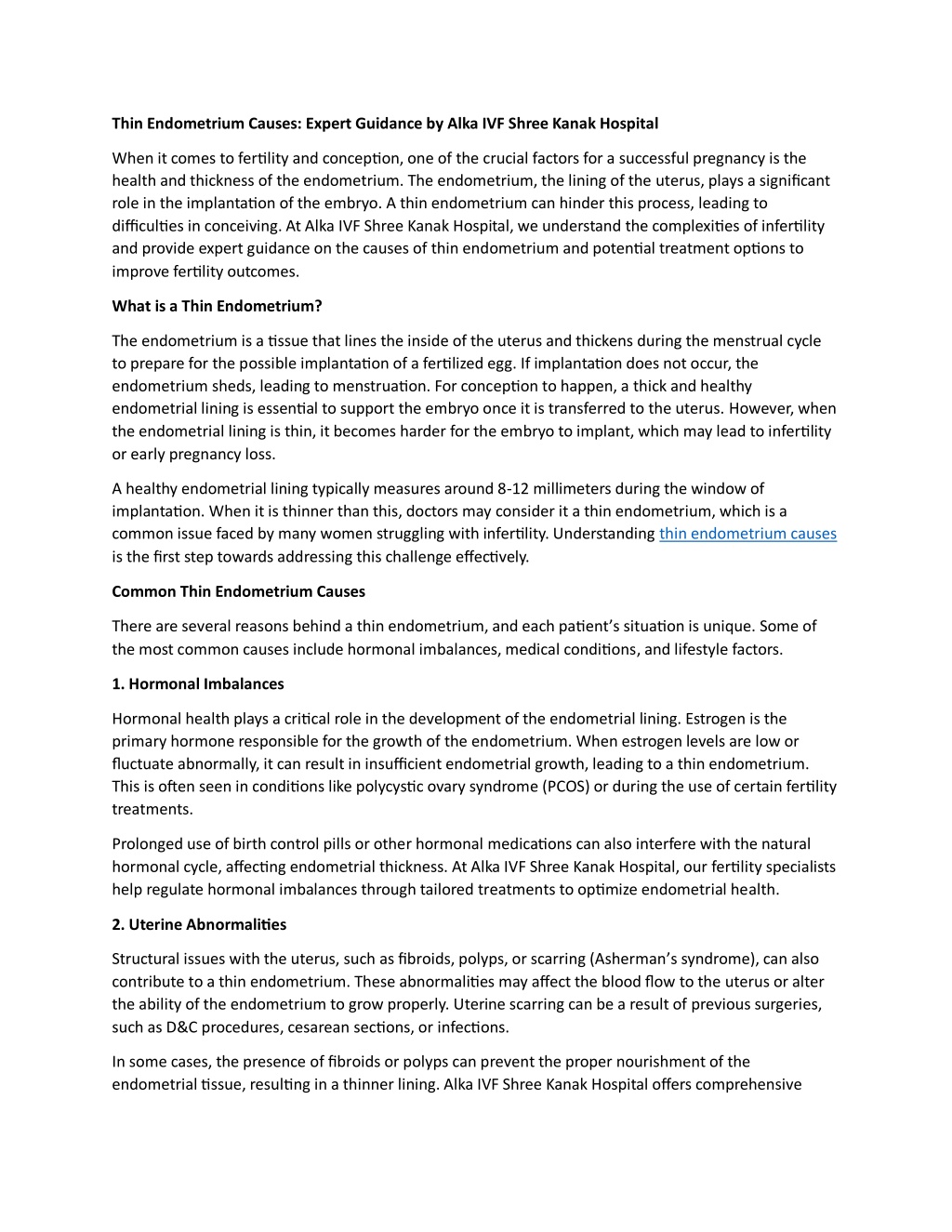
Thin Endometrium Cause14 december
thin endometrium causes
Download Presentation

Please find below an Image/Link to download the presentation.
The content on the website is provided AS IS for your information and personal use only. It may not be sold, licensed, or shared on other websites without obtaining consent from the author. Download presentation by click this link. If you encounter any issues during the download, it is possible that the publisher has removed the file from their server.
E N D
Presentation Transcript
Thin Endometrium Causes: Expert Guidance by Alka IVF Shree Kanak Hospital When it comes to fertility and conception, one of the crucial factors for a successful pregnancy is the health and thickness of the endometrium. The endometrium, the lining of the uterus, plays a significant role in the implantation of the embryo. A thin endometrium can hinder this process, leading to difficulties in conceiving. At Alka IVF Shree Kanak Hospital, we understand the complexities of infertility and provide expert guidance on the causes of thin endometrium and potential treatment options to improve fertility outcomes. What is a Thin Endometrium? The endometrium is a tissue that lines the inside of the uterus and thickens during the menstrual cycle to prepare for the possible implantation of a fertilized egg. If implantation does not occur, the endometrium sheds, leading to menstruation. For conception to happen, a thick and healthy endometrial lining is essential to support the embryo once it is transferred to the uterus. However, when the endometrial lining is thin, it becomes harder for the embryo to implant, which may lead to infertility or early pregnancy loss. A healthy endometrial lining typically measures around 8-12 millimeters during the window of implantation. When it is thinner than this, doctors may consider it a thin endometrium, which is a common issue faced by many women struggling with infertility. Understanding thin endometrium causes is the first step towards addressing this challenge effectively. Common Thin Endometrium Causes There are several reasons behind a thin endometrium, and each patient s situation is unique. Some of the most common causes include hormonal imbalances, medical conditions, and lifestyle factors. 1. Hormonal Imbalances Hormonal health plays a critical role in the development of the endometrial lining. Estrogen is the primary hormone responsible for the growth of the endometrium. When estrogen levels are low or fluctuate abnormally, it can result in insufficient endometrial growth, leading to a thin endometrium. This is often seen in conditions like polycystic ovary syndrome (PCOS) or during the use of certain fertility treatments. Prolonged use of birth control pills or other hormonal medications can also interfere with the natural hormonal cycle, affecting endometrial thickness. At Alka IVF Shree Kanak Hospital, our fertility specialists help regulate hormonal imbalances through tailored treatments to optimize endometrial health. 2. Uterine Abnormalities Structural issues with the uterus, such as fibroids, polyps, or scarring (Asherman s syndrome), can also contribute to a thin endometrium. These abnormalities may affect the blood flow to the uterus or alter the ability of the endometrium to grow properly. Uterine scarring can be a result of previous surgeries, such as D&C procedures, cesarean sections, or infections. In some cases, the presence of fibroids or polyps can prevent the proper nourishment of the endometrial tissue, resulting in a thinner lining. Alka IVF Shree Kanak Hospital offers comprehensive
diagnostic services and treatment options, including minimally invasive surgery to address these issues and improve the chances of conception. 3. Poor Blood Flow to the Uterus Adequate blood supply is vital for the growth and maintenance of the endometrial lining. Poor uterine blood flow can result in a thin endometrium. This condition can be caused by various factors such as high blood pressure, diabetes, or smoking. These factors can restrict blood flow to the uterus, impairing the nourishment of the endometrium. Women who are at risk of poor blood circulation can benefit from treatments designed to improve uterine blood flow. At Alka IVF Shree Kanak Hospital, we offer a variety of interventions such as lifestyle counseling, medications, and medical procedures to help improve circulation and promote endometrial growth. 4. Advanced Maternal Age As women age, particularly after the age of 35, hormonal fluctuations and a decline in ovarian reserve can impact the growth of the endometrial lining. Additionally, the ability of the uterus to respond to hormones may diminish over time, contributing to a thinner endometrium. Advanced maternal age is a significant risk factor for infertility, and women with thin endometrial linings may face additional challenges. However, with the right fertility treatments, including controlled ovarian stimulation and the use of hormone therapy, Alka IVF Shree Kanak Hospital can help women in this age group achieve successful pregnancies. 5. Lifestyle Factors Certain lifestyle factors can also affect the thickness of the endometrial lining. For instance, excessive exercise, chronic stress, or an unhealthy diet can interfere with hormone production and overall reproductive health. Women who are underweight may experience a lack of estrogen, leading to a thin endometrium. Maintaining a healthy weight, managing stress, and avoiding harmful habits like smoking and excessive alcohol consumption can help promote endometrial health. At Alka IVF Shree Kanak Hospital, we provide personalized lifestyle advice and fertility counseling to ensure that every factor is optimized for the best chance of pregnancy. Diagnosis and Treatment of Thin Endometrium To accurately diagnose thin endometrium, a combination of tests and procedures is necessary. These may include: Ultrasound to measure the thickness of the endometrium. Hormonal blood tests to check for imbalances. Hysteroscopy to evaluate the uterus for abnormalities such as fibroids or scarring. Once the underlying cause of a thin endometrium is identified, treatment options can be tailored accordingly. Some of the most effective treatments include:
Hormonal therapy to regulate estrogen levels and stimulate endometrial growth. Intrauterine infusion of platelet-rich plasma (PRP) to promote healing and improve blood flow to the uterus. Stem cell therapy to regenerate endometrial tissue. Surgical interventions for uterine abnormalities or scarring. Conclusion A thin endometrium can be a challenging issue for women trying to conceive, but with the right diagnosis and treatment, it is possible to improve endometrial thickness and achieve a successful pregnancy. Alka IVF Shree Kanak Hospital offers expert care in addressing the thin endometrium causes and provides personalized treatment options to improve fertility outcomes. If you suspect that a thin endometrium is impacting your fertility, consult with the specialists at Alka IVF Shree Kanak Hospital for a comprehensive evaluation and customized treatment plan tailored to your needs. With our advanced technologies, expert team, and compassionate care, we are committed to helping you achieve your dream of parenthood.






















